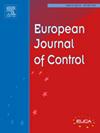Relationship between the regulation performance of control systems and the spatial clustering parameters based on pattern-moving
IF 2.6
3区 计算机科学
Q2 AUTOMATION & CONTROL SYSTEMS
引用次数: 0
Abstract
The pattern-moving control problem of a class of nonlinear systems governed by statistical laws is studied. Also, the influence of clustering parameters for constructing pattern-moving space in pattern-moving control methods on system regulation performance has been studied. Firstly, based on the pattern-moving system dynamics description method, a data-driven control method based on the probability density evolution of pattern-moving is proposed. Furthermore, performance indicators with statistical properties are provided to describe the system’s regulation performance, and an improved ISODATA clustering algorithm suitable for constructing pattern-moving spaces is proposed. Then, by constructing a classification neural network, the relationship between clustering algorithm parameters and system regulation performance is established. The simulation results show that the proposed control algorithm can effectively control the system governed by statistical laws, and the constructed neural network can provide a basis for selecting clustering parameters in the pattern-moving space.
基于模式移动的空间聚类参数与控制系统调节性能的关系
研究了一类受统计律支配的非线性系统的模式运动控制问题。同时,研究了动模控制方法中构造动模空间的聚类参数对系统调节性能的影响。首先,在模式运动系统动力学描述方法的基础上,提出了一种基于模式运动概率密度演化的数据驱动控制方法。在此基础上,提出了具有统计性质的性能指标来描述系统的调节性能,并提出了一种适用于构造模式移动空间的改进的ISODATA聚类算法。然后,通过构建分类神经网络,建立了聚类算法参数与系统调节性能之间的关系。仿真结果表明,所提出的控制算法可以有效地控制受统计规律支配的系统,所构建的神经网络可以为在模式移动空间中选择聚类参数提供依据。
本文章由计算机程序翻译,如有差异,请以英文原文为准。
求助全文
约1分钟内获得全文
求助全文
来源期刊

European Journal of Control
工程技术-自动化与控制系统
CiteScore
5.80
自引率
5.90%
发文量
131
审稿时长
1 months
期刊介绍:
The European Control Association (EUCA) has among its objectives to promote the development of the discipline. Apart from the European Control Conferences, the European Journal of Control is the Association''s main channel for the dissemination of important contributions in the field.
The aim of the Journal is to publish high quality papers on the theory and practice of control and systems engineering.
The scope of the Journal will be wide and cover all aspects of the discipline including methodologies, techniques and applications.
Research in control and systems engineering is necessary to develop new concepts and tools which enhance our understanding and improve our ability to design and implement high performance control systems. Submitted papers should stress the practical motivations and relevance of their results.
The design and implementation of a successful control system requires the use of a range of techniques:
Modelling
Robustness Analysis
Identification
Optimization
Control Law Design
Numerical analysis
Fault Detection, and so on.
 求助内容:
求助内容: 应助结果提醒方式:
应助结果提醒方式:


